2005 Hyundai Terracan tyre pressure
[x] Cancel search: tyre pressurePage 458 of 539
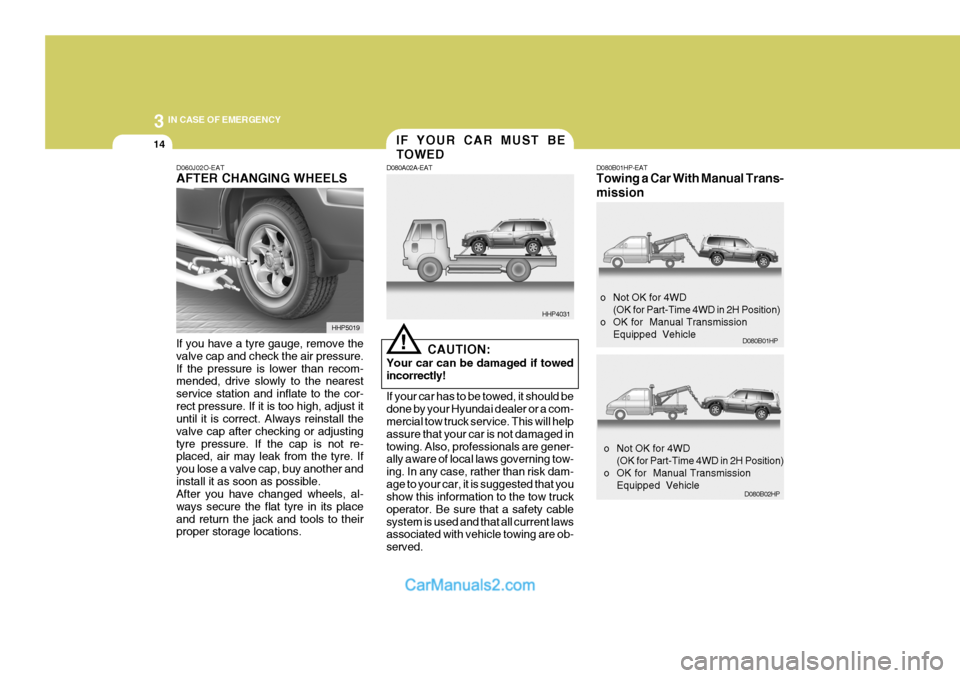
3 IN CASE OF EMERGENCY
14
!
CAUTION:
Your car can be damaged if towed incorrectly! If your car has to be towed, it should be done by your Hyundai dealer or a com- mercial tow truck service. This will help assure that your car is not damaged intowing. Also, professionals are gener- ally aware of local laws governing tow- ing. In any case, rather than risk dam-age to your car, it is suggested that you show this information to the tow truck operator. Be sure that a safety cablesystem is used and that all current laws associated with vehicle towing are ob- served. D080B01HP-EAT Towing a Car With Manual Trans- mission
D060J02O-EAT AFTER CHANGING WHEELS If you have a tyre gauge, remove the valve cap and check the air pressure.If the pressure is lower than recom- mended, drive slowly to the nearest service station and inflate to the cor-rect pressure. If it is too high, adjust it until it is correct. Always reinstall the valve cap after checking or adjustingtyre pressure. If the cap is not re- placed, air may leak from the tyre. If you lose a valve cap, buy another andinstall it as soon as possible. After you have changed wheels, al- ways secure the flat tyre in its placeand return the jack and tools to their proper storage locations.
HHP5019
IF YOUR CAR MUST BE TOWED
HHP4031
D080A02A-EAT
o Not OK for 4WD
(OK for Part-Time 4WD in 2H Position)
o OK for Manual Transmission Equipped Vehicle
D080B02HP
D080B01HP
o Not OK for 4WD (OK for Part-Time 4WD in 2H Position)
o OK for Manual Transmission Equipped Vehicle
Page 472 of 539

5
VEHICLE MAINTENANCE REQUIREMENTS
5
20 24
I
R II I I
RR II I I I I I I I I I I I I I I I
F030C06HP-EAT R : Replace I : Inspect and, after inspection, clean, adjust, repair or replace if necessary
DESCRIPTION
GENERAL MAINTENANCE COOLING SYSTEM COOLANT COOLANT SPECIFIC GRAVITY MANUAL TRANSMISSION OIL AUTOMATIC TRANSMISSION FLUID AND FILTER BRAKE PIPES, HOSES, AND CONNECTIONS BRAKE FLUID CLUTCH FLUID
REAR BRAKE LININGS, CYLINDERS AND PARKING BRAKE BRAKE PADS, CALIPERS AND ROTORS SUSPENSION AND STEERING SYSTEM FRONT SUSPENSION BALL JOINTS
STEERING GEAR BOX, LINKAGE AND BOOTS, LOWER ARM BALL JOINT, UPPER ARM BALL JOINT
DRIVE SHAFT AND BOOTS TRANSFER CASE OIL AXLE GEAR OIL CLEAN PROPELLER SHAFT/RETIGHTEN BOLTS REAR WHEEL BEARINGS TYRE CONDITION AND PRESSURE (incl. Spare) LUBRICATE LOCKS AND HINGES CHECK ALL ELECTRICAL SYSTEMS ROAD TEST CHECK ALL SYSTEMS WITH HI-SCAN CHECK EMISSIONS CHECK 4 WHEEL ALIGNMENT
NO.
1
2 3 4 5 6 7 8 9
1011 12 13 14 15 16 17 18 19 20 21 22 23 24 25
60 72
I
RR II
R
I
RR II I I I I I I I I I I I I I I I
50 60
I I I I I I I I I I I I I I I I I I I I I I I
40 48
I
R II I I
RR II I I I I I
R I I I I I I I I I
30
36
I
R
I I I I I I I I I I I I I I I I I I I I I I
10 12
I I I I I I I I I I I I I
R I I I I I I I I I
MILES X 1000MONTHS
Petrol Engine Diesel Engine
Page 481 of 539
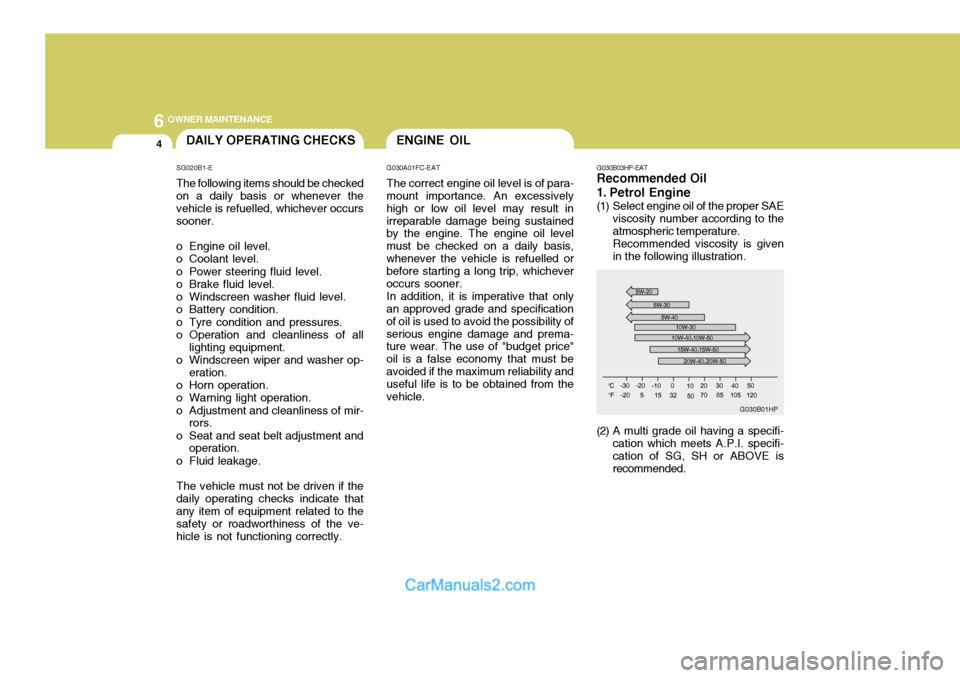
6 OWNER MAINTENANCE
4
G030B03HP-EAT
Recommended Oil
1. Petrol Engine
(1) Select engine oil of the proper SAE
viscosity number according to the atmospheric temperature.Recommended viscosity is givenin the following illustration.
(2) A multi grade oil having a specifi- cation which meets A.P.I. specifi-cation of SG, SH or ABOVE isrecommended.DAILY OPERATING CHECKS
SG020B1-E The following items should be checked on a daily basis or whenever the vehicle is refuelled, whichever occurssooner.
o Engine oil level.
o Coolant level.
o Power steering fluid level.
o Brake fluid level.
o Windscreen washer fluid level.
o Battery condition.
o Tyre condition and pressures.
o Operation and cleanliness of all lighting equipment.
o Windscreen wiper and washer op-
eration.
o Horn operation.
o Warning light operation.
o Adjustment and cleanliness of mir- rors.
o Seat and seat belt adjustment and operation.
o Fluid leakage. The vehicle must not be driven if the daily operating checks indicate that any item of equipment related to the safety or roadworthiness of the ve-hicle is not functioning correctly.ENGINE OIL
G030A01FC-EAT The correct engine oil level is of para-
mount importance. An excessively high or low oil level may result inirreparable damage being sustained by the engine. The engine oil level must be checked on a daily basis,whenever the vehicle is refuelled or before starting a long trip, whichever occurs sooner.
In addition, it is imperative that only
an approved grade and specificationof oil is used to avoid the possibility ofserious engine damage and prema- ture wear. The use of "budget price" oil is a false economy that must beavoided if the maximum reliability and useful life is to be obtained from the vehicle.
G030B01HP
Page 510 of 539

6
OWNER MAINTENANCE
33
And then, draw a parallel line at 1.50 in. (38 mm) under the horizontal line incase of adjusting the low beam or at 0.83 in. (21 mm) under the horizontal line in case of adjusting the high beam.
7. Adjust each cut-off line of the low beam to the parallel line with a phillips screwdriver - VERTICAL AIMING.
8. Adjust each cut-off line of the low beam to the each vertical line witha phillips screwdriver - HORIZON-TAL AIMING.
Before performing aiming adjustment,make sure of the following.HEADLIGHT AIMING AD- JUSTMENT
G290A01HP-EAT
1. Keep all tyres inflated to the correct
pressure.
2. Place the vehicle on level ground and press the front bumper & rear bumper down several times. Placevehicle at a distance of 118.1 in. (3m) from the test wall.
3. See that the vehicle is unloaded (except for full levels of coolant, engine oil and fuel, and spare tyre,jack, and tools). Have the driver or equivalent weight placed in driver's seat.
4. Clean the headlight lens and turn on the headlight.
5. Open the bonnet.
6. Draw the vertical line (through the centre of each headlight) and thehorizontal line (through the centre of each headlight) on the aiming screen.
(1) Horizontal line dimension from
Horizontal aiming
Vertical aiming
G290B01HP
G290B02HP
Horizontal aiming
Vertical aiming
ground : Low Beam : 35.1 in.(894 mm) High Beam : 33 in. (839 mm)
(2) Distance between each vertical line :Low Beam : 51.8 in. (1,316 mm) High Beam : 42.4 in. (1,076 mm)
Page 523 of 539
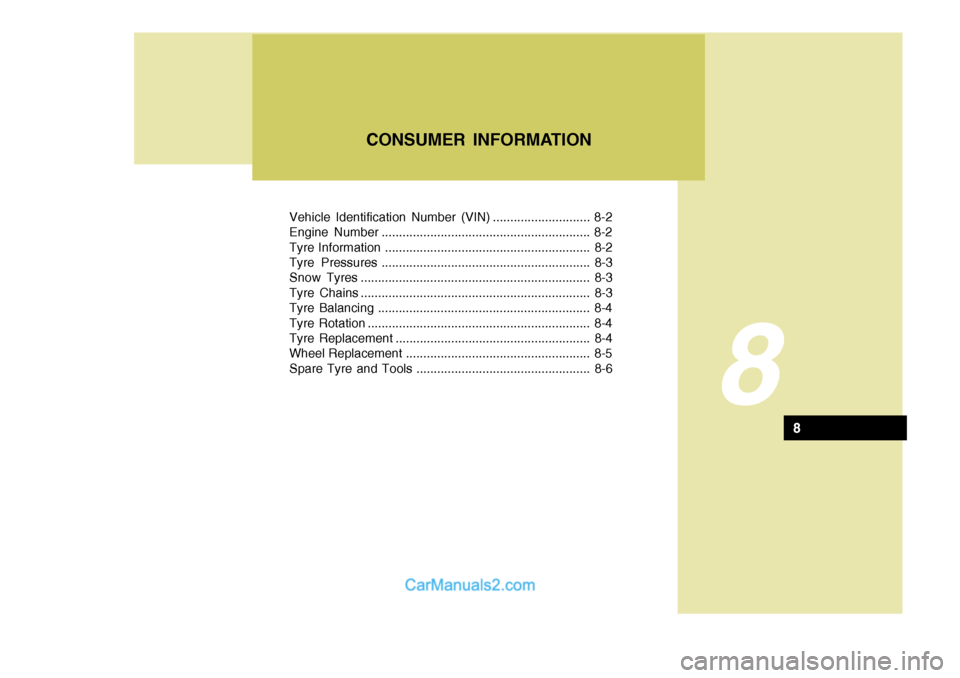
Vehicle Identification Number (VIN) ............................ 8-2
Engine Number ............................................................ 8-2
Tyre Information ........................................................... 8-2
Tyre Pressures ............................................................ 8-3
Snow Tyres .................................................................. 8-3
Tyre Chains .................................................................. 8-3
Tyre Balancing ............................................................. 8-4
Tyre Rotation ................................................................ 8-4
Tyre Replacement ........................................................ 8-4
Wheel Replacement ..................................................... 8-5
Spare Tyre and Tools .................................................. 8-6
8
CONSUMER INFORMATION
8
Page 525 of 539
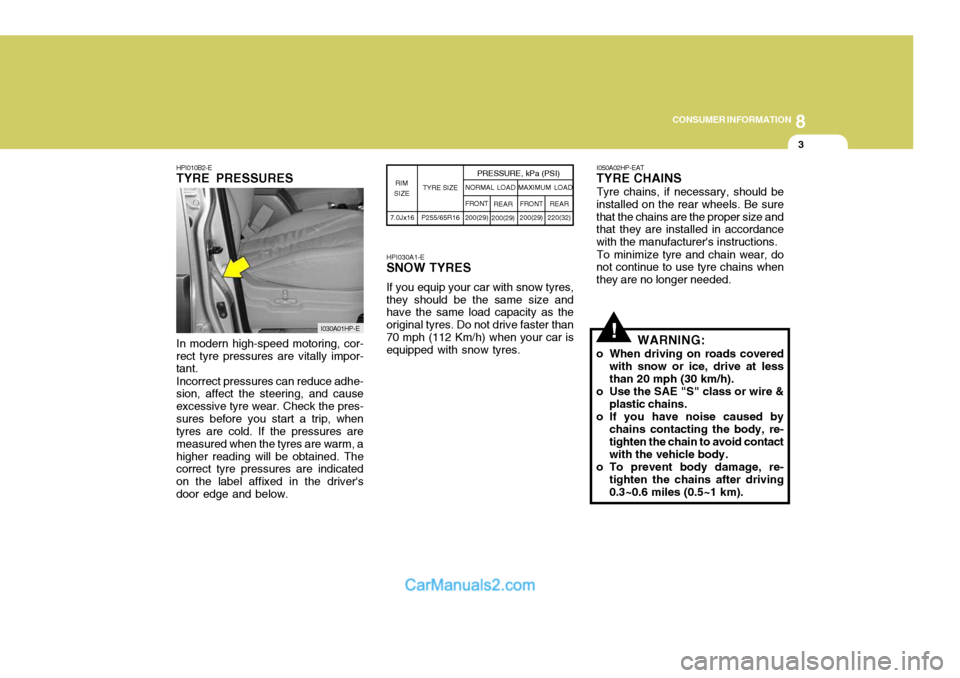
8
CONSUMER INFORMATION
3
!In modern high-speed motoring, cor-
rect tyre pressures are vitally impor- tant.
Incorrect pressures can reduce adhe-
sion, affect the steering, and cause excessive tyre wear. Check the pres-sures before you start a trip, when tyres are cold. If the pressures are measured when the tyres are warm, ahigher reading will be obtained. The correct tyre pressures are indicated on the label affixed in the driver'sdoor edge and below. HPI030A1-E SNOW TYRES If you equip your car with snow tyres, they should be the same size and have the same load capacity as the original tyres. Do not drive faster than70 mph (112 Km/h) when your car is equipped with snow tyres.
I050A02HP-EAT
TYRE CHAINS
Tyre chains, if necessary, should be
installed on the rear wheels. Be sure that the chains are the proper size and that they are installed in accordance with the manufacturer's instructions.
To minimize tyre and chain wear, do
not continue to use tyre chains whenthey are no longer needed.
WARNING:
o When driving on roads covered with snow or ice, drive at lessthan 20 mph (30 km/h).
o Use the SAE "S" class or wire &
plastic chains.
o If you have noise caused by chains contacting the body, re-tighten the chain to avoid contact with the vehicle body.
o To prevent body damage, re- tighten the chains after driving0.3~0.6 miles (0.5~1 km).
7.0Jx16
TYRE SIZE
RIM
SIZE PRESSURE, kPa (PSI)
P255/65R16 REAR
200(29) FRONT
200(29)
NORMAL LOAD MAXIMUM LOAD
REAR
220(32)
FRONT 200(29)
HPI010B2-E
TYRE PRESSURES
I030A01HP-E
Page 530 of 539
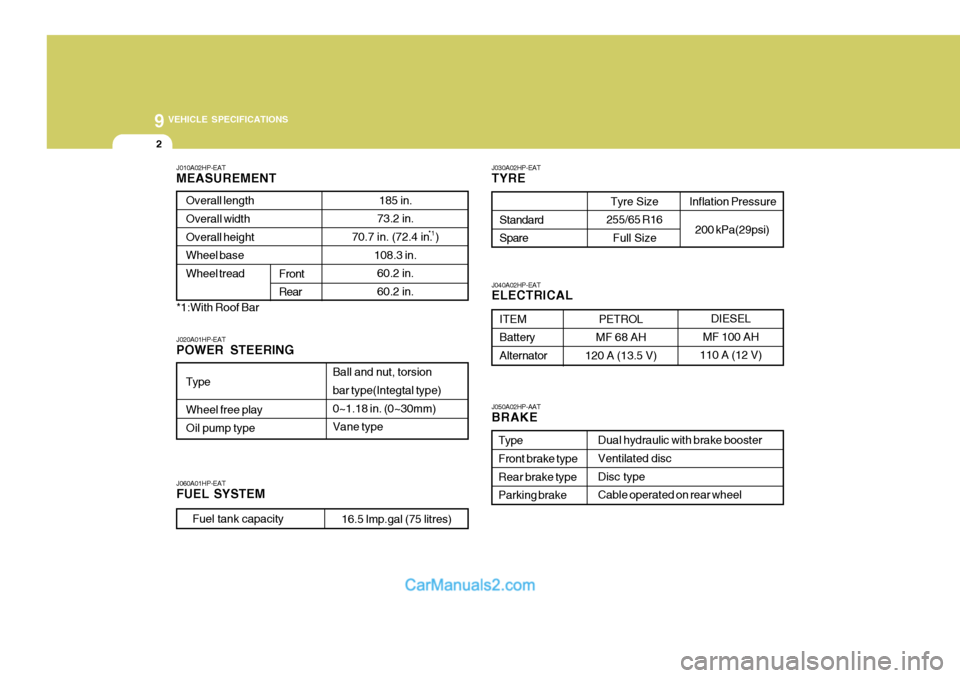
9 VEHICLE SPECIFICATIONS
2
PETROL
MF 68 AH
120 A (13.5 V)
J010A02HP-EAT MEASUREMENT
185 in.
73.2 in.
70.7 in. (72.4 in. )
108.3 in.60.2 in. 60.2 in.
Overall lengthOverall width Overall height Wheel baseWheel tread
Front Rear
J060A01HP-EAT FUEL SYSTEM J030A02HP-EATTYRE
Standard Spare
J050A02HP-AAT BRAKE Dual hydraulic with brake booster Ventilated disc Disc typeCable operated on rear wheel
TypeFront brake type Rear brake type Parking brake
ITEM Battery Alternator
J040A02HP-EAT ELECTRICAL
Fuel tank capacity
DIESEL
MF 100 AH
110 A (12 V)
Tyre Size
255/65 R16
Full Size
16.5 lmp.gal (75 litres)
*1:With Roof Bar
*1
Type
Ball and nut, torsion bar type(Integtal type) 0~1.18 in. (0~30mm) Vane type
J020A01HP-EAT POWER STEERING
Wheel free play Oil pump type
Inflation Pressure
200 kPa(29psi)
Page 538 of 539
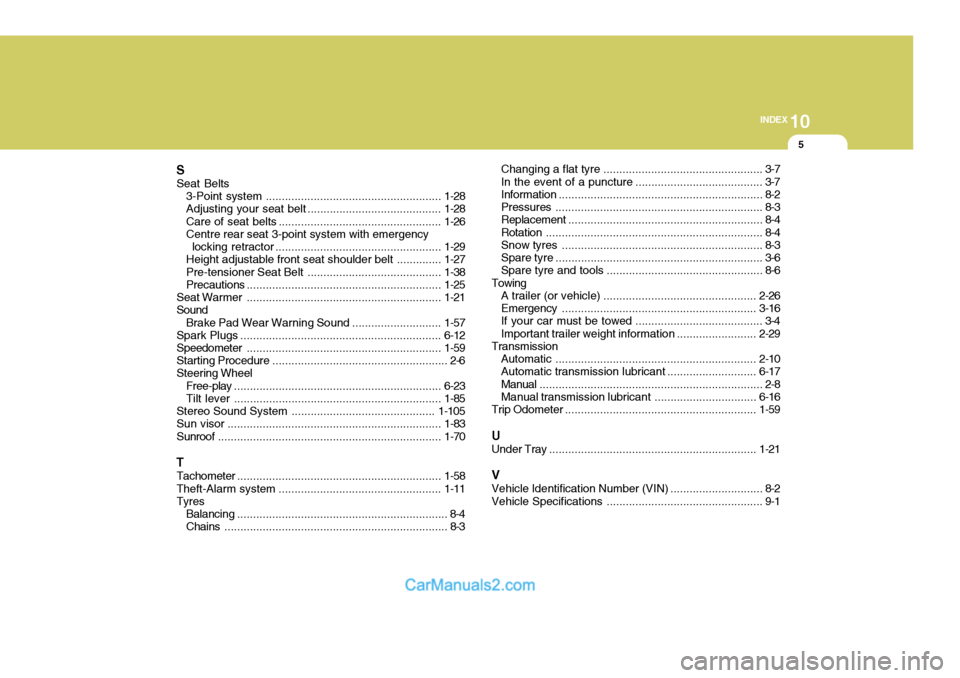
10
INDEX
5
S Seat Belts 3-Point system ....................................................... 1-28
Adjusting your seat belt .......................................... 1-28
Care of seat belts ................................................... 1-26
Centre rear seat 3-point system with emergency
locking retractor .................................................... 1-29
Height adjustable front seat shoulder belt ..............1-27
Pre-tensioner Seat Belt .................. ........................1-38
Precautions ............................................................. 1-25
Seat Warmer ............................................................. 1-21
Sound
Brake Pad Wear Warning Sound ............................ 1-57
Spark Plugs ............................................................... 6-12
Speedometer ............................................................. 1-59
Starting Procedure ....................................................... 2-6
Steering Wheel
Free-play ................................................................. 6-23
Tilt lever ................................................................. 1-85
Stereo Sound System ............................................. 1-105
Sun visor ................................................................... 1-83
Sunroof ...................................................................... 1-70
T Tachometer ................................................................ 1-58
Theft-Alarm system ................................................... 1-11
Tyres
Balancing .................................................................. 8-4
Chains ...................................................................... 8-3 Changing a flat
tyre .................................................. 3-7
In the event of a puncture ........................................ 3-7 Information ................................................................ 8-2
Pressures ................................................................. 8-3
Replacement ............................................................. 8-4
Rotation .................................................................... 8-4
Snow tyres ............................................................... 8-3
Spare tyre ................................................................. 3-6Spare tyre and tools ................................................. 8-6
Towing A trailer (or vehicle) ................................................ 2-26
Emergency ............................................................. 3-16
If your car must be towed ........................................ 3-4 Important trailer weight information ......................... 2-29
Transmission
Automa tic ............................................................... 2-10
Automatic transmission lubricant ............................ 6-17
Manual ...................................................................... 2-8
Manual transmission lubricant ................................ 6-16
Trip Odometer ............................................................ 1-59
U Under Tray ................................................................. 1-21
VVehicle Identification Number (VIN) ............................. 8-2
Vehicle Specifica tions ................................................. 9-1